If you are curious about how a tattoo gun works and the intricate process behind creating a tattoo, then this guide will provide you with a detailed look at the mechanics of a tattoo gun. We will explain the components of a tattoo gun, how it works, and the techniques used to create a tattoo. By the end of this guide, you will have a better understanding of the intricacies behind this popular body art form.
Contents
Types of Tattoo Guns
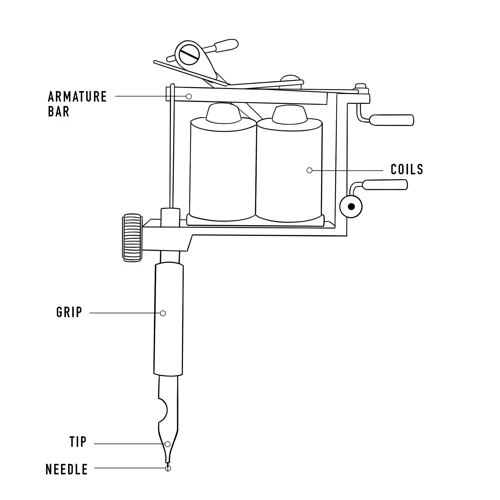
Rotary Tattoo Machines
Rotary tattoo machines are powered by an electric motor which drives a needle up and down. They are the most commonly used type of tattoo machines and are preferred for their reliability and precision. Depending on the design, these machines can be used for lining, shading, and coloring. The needles used in rotary machines are usually soldered onto a circular bar which allows for a more precise and consistent line.
Coil Tattoo Machines
Coil tattoo machines are powered by an electromagnet and use electromagnetic coils to drive the needles up and down. They are often used for lining and shading as they have a higher frequency, allowing for more precise and consistent work. Coil machines are generally heavier than rotary machines and require more maintenance. The needles used in coil machines are usually soldered onto a metal bar.
No matter which type of machine is used, understanding how do tattoo machines work is the key to achieving successful tattoos. Both types of machines use needles to puncture the skin and inject ink, creating a permanent design. However, the difference lies in the way the needles are driven up and down. Although both machines are capable of creating beautiful tattoos, it’s important to understand the intricacies of how each machine works in order to get the best possible result.
Components of a Tattoo Gun
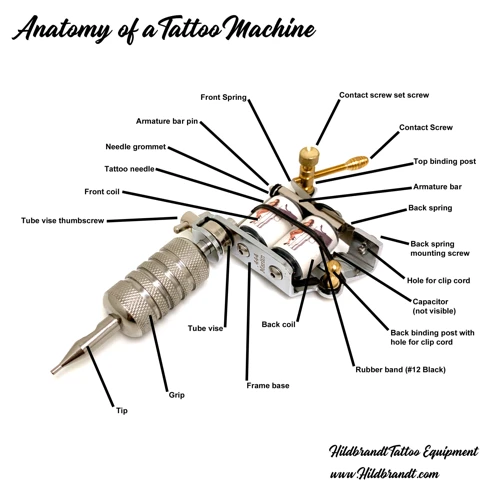
Motor
The motor powers the tattoo gun and is the core component that allows the machine to work. The motor is usually an electromagnetic coil, which is able to generate a strong magnetic field when energized. This magnetic field is then used to move the needle arm up and down rapidly and repeatedly to create the desired tattoo design.
Needle
The needle is the part of the tattoo gun that actually pierces the skin and injects the ink. It is attached to the needle arm, which is in turn moved up and down by the motor. The needles come in various sizes and shapes, and the size and shape determine the type of tattoo that can be created.
Tube
The tube is the part of the tattoo gun that holds the ink. It is usually made of plastic or metal and is connected to the needle arm. The tube allows the ink to flow through the needle arm and into the skin.
Power Supply
The power supply of a tattoo gun is an essential piece of equipment. It is usually a battery or an electrical cord. The power supply provides the necessary power to the motor, allowing it to create the strong magnetic field needed to move the needle arm. Without a power supply, a tattoo gun would not be able to work.
A tattoo gun is a complex piece of machinery, and understanding how does a tattoo machine work is essential for anyone considering getting a tattoo. By understanding the components of a tattoo gun and how they work together, it is easier to choose the right equipment for the job.
How a Tattoo Gun Works
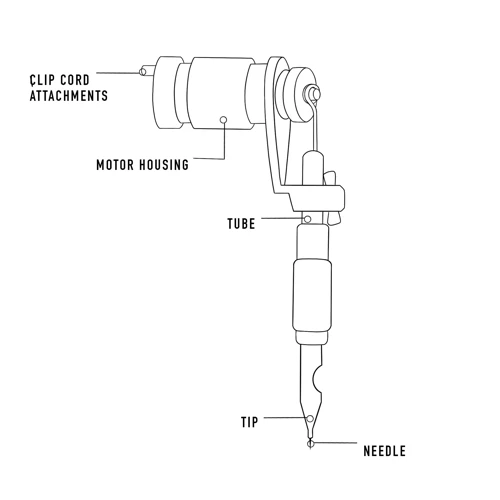
Rotary Tattoo Machines
Rotary tattoo machines use a motor to power the needle. The motor is connected to the armature bar, which is responsible for moving the needle up and down. It is controlled by the artist’s hand and is used to create a consistent and precise line. The motor also powers a capacitor, which is a device that stores energy and allows the machine to maintain a consistent speed. This helps create a smooth and even tattoo.
Coil Tattoo Machines
Coil tattoo machines are powered by electromagnetic coils. These coils create a magnetic field that causes the armature bar to move up and down, pushing the needle into the skin. The coils also regulate the speed at which the needle moves, allowing the artist to create a precise and consistent line. The power of the machine is determined by the size of the coils and the amount of voltage they can produce. This allows the artist to control the depth and intensity of the tattoo.
Tattoo guns are an essential tool for any artist, allowing them to create beautiful, custom designs. By understanding how they work, artists can better control the depth and intensity of their work, ensuring the best results for their clients. Knowing how do tattoo guns work can help any artist create unique and stunning tattoos.
Benefits of a Tattoo Gun
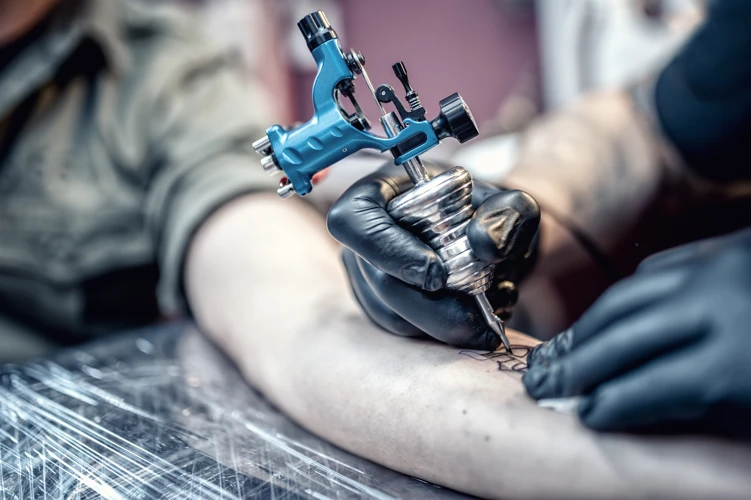
- Versatility – Tattoo guns are incredibly versatile, allowing you to create a range of styles and designs. Whether you’re an artist looking to create unique art or a tattooist looking to create detailed designs, a tattoo gun is the perfect tool.
- Precision – Tattoo guns allow you to work with incredible precision, giving you the ability to create intricate designs with ease. This precision can be invaluable when it comes to creating complex designs or working with detailed lines.
- Durability – Tattoo guns are incredibly durable, allowing you to use them for years. They’re designed to withstand the rigors of professional tattooing, so you can be sure that your tattoo gun will last for a long time.
- Ease of Use – Tattoo guns are incredibly easy to use, even for beginners. The simple controls make it easy to learn the basics, and you can quickly master the art of tattooing with practice.
- Safety – Tattoo guns are designed to be safe to use. They come with safety features such as a shut-off switch to prevent accidental injury and a needle guard to protect the skin. This helps to ensure that your tattooing experience is as safe and comfortable as possible.
Disadvantages of a Tattoo Gun
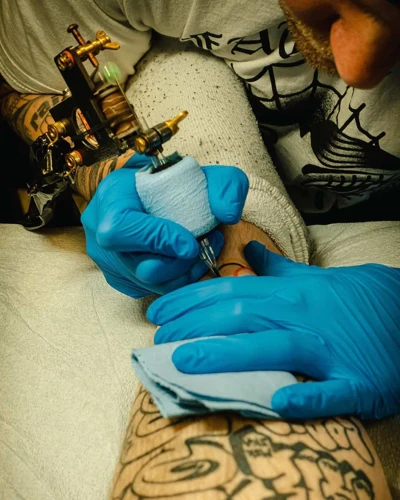
- Infection: Tattoo guns are tools that are used to puncture the skin, thus making it more prone to infection. If not properly sterilized, these guns can easily transfer infections such as HIV and Hepatitis.
- Pain: Tattoo guns cause pain as they puncture the skin. This pain may be unbearable for some people and can cause them to faint.
- Scarring: Tattoo guns can cause scarring in the form of keloiding, which is an excessive accumulation of scar tissue. It is important to ensure that the gun is properly sterilized before use to reduce the risk of infection and scarring.
- Allergic Reactions: People who are allergic to certain inks may experience adverse reactions when these inks are injected into the skin with a tattoo gun.
- Blood Splatter: Blood splatter from the tattoo gun can occur if the gun is not properly sterilized. This could pose a health risk to both the tattoo artist and the customer.
Safety Concerns
Tattoo guns are powerful tools and must be handled with care. The needles used in tattoo guns are sharp and can cause serious injury if not handled correctly. It is important to keep the gun in a safe and clean place, and to always use the correct protective equipment. Additionally, it is important to use a sterilized needle and ink for each tattoo.
Using the correct techniques while using a tattoo gun is also very important. Ensure that the gun is set to the correct depth – too deep may cause unnecessary pain and too shallow may not leave an effective mark. Additionally, take regular breaks when tattooing and make sure to clean the area afterwards.
In addition to the above, there are some other safety steps to keep in mind when using a tattoo gun.
| Safety Step | Description |
|---|---|
| Disinfect the area | Clean the area with a disinfectant before starting to tattoo. |
| Wear protective clothing | Wear latex gloves and other protective clothing to avoid any contact with blood. |
| Use a single-use needle | Make sure to use a single-use needle for each tattoo to minimize the risk of infection. |
| Dispose of needles correctly | Make sure to dispose of needles in a safe and responsible manner. |
It is also important to be aware of the laws regarding tattooing in your area. Different countries and states have different laws and regulations regarding tattooing, so make sure to familiarize yourself with the laws in your area before tattooing.
Frequently Asked Questions
What are the Different Components of a Tattoo Gun?
A tattoo gun is made up of several components, each of which plays a vital role in the process of creating tattoos. The components are:
- Motor – This is the part of the gun that creates the vibration necessary for the needle to puncture the skin.
- Needle – This is the part of the gun that penetrates the skin and injects the ink into the dermis layer.
- Grip – This is the part of the gun that is held by the tattoo artist and is used to guide the needle.
- Armature Bar – This is the part of the gun that connects the needle to the motor.
- Tube – This is the part of the gun that holds the ink and is connected to the needle.
- Power Supply – This is the part of the gun that powers the motor and is responsible for creating the vibration necessary for the needle to puncture the skin.
These components work together to create a tattoo. The motor creates the vibration necessary for the needle to puncture the skin, the needle injects the ink into the dermis layer, the grip is used to guide the needle, the armature bar connects the needle to the motor, the tube holds the ink and the power supply powers the motor.
How Should I Prepare My Skin Before Getting a Tattoo?
-
1. Clean and Exfoliate Your Skin: Before your appointment, make sure to clean and exfoliate your skin. This ensures that any dirt, oil, or sweat on your skin won’t interfere with the ink.
2. Do Not Tan: Avoid tanning before getting a tattoo as the sun’s UV rays can cause the ink to fade faster.
3. Avoid Chemical Products: Do not use any chemical products such as lotions, moisturizers, and makeup on the area where you’re getting the tattoo.
4. Shave the Area: If the area you’re getting the tattoo is hairy, make sure to shave it the day before your appointment.
5. Moisturize: Moisturizing the skin a few days before your appointment will make the skin more pliable, which makes it easier for the tattoo artist to work with.
What kind of power source is needed to operate a tattoo gun?
A tattoo gun requires a power source to run. Typically, this is either a power supply unit, a battery, or a foot switch. The power supply unit plugs into a wall outlet, and is used to regulate the power and speed of the tattoo gun. Battery packs are usually used for portability, and the foot switch allows the artist to control the power and speed of the gun without having to use their hands.
How Often Should I Change the Needle of a Tattoo Gun?
Changing the needle is a crucial part of tattooing:
- The needle should be changed before each and every tattoo.
- If you are using a pre-sterilized needle, it should be discarded after each use.
- If you are using a needle that requires sterilization, it should be autoclaved and reused, but changed after every 3-4 sessions.
- Regularly inspect the tattoo gun needle for signs of wear or damage and replace it if necessary.
It is important to remember that new needles should always be used for each individual tattoo. Even if the needle is sterile, it should be changed after every use, as the needle may become bent, loose, or damaged over time. Additionally, needles should be regularly inspected for signs of wear and damage and replaced if necessary.
What Safety Precautions Should I Take When Using a Tattoo Gun?
Always wear protective eyewear and gloves when handling the tattoo gun. Make sure the gun is securely attached to a power source and all cords are fully connected. Ensure the needle and the tube are securely connected to the gun. Disinfect the area to be tattooed and the gun itself before use. Avoid cross-contamination by using a new needle for every person. Discard needles and tubes in a sharps container.
Conclusion
The tattoo gun is the most important tool in the tattoo artist’s arsenal. Understanding how it works and how to use it properly is essential to creating beautiful, lasting tattoos. With the right knowledge and practice, anyone can learn to use a tattoo gun safely and effectively.